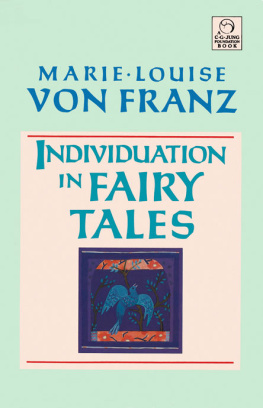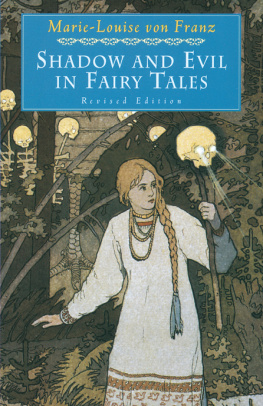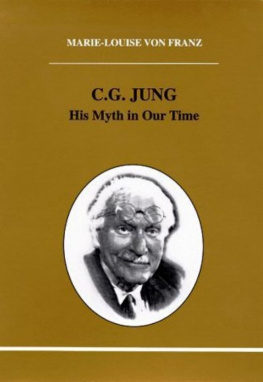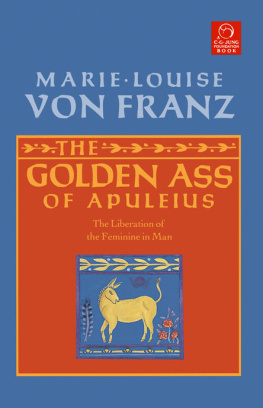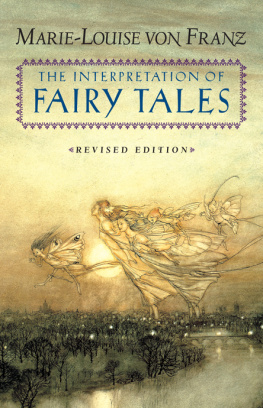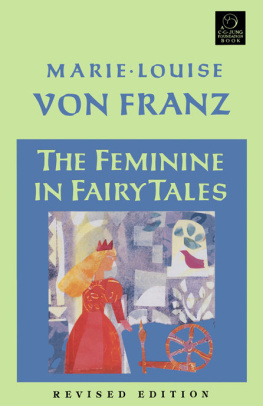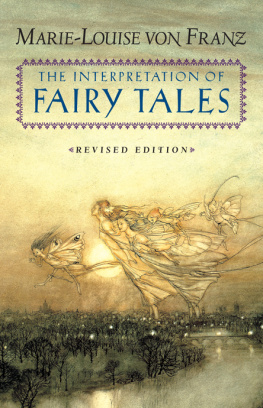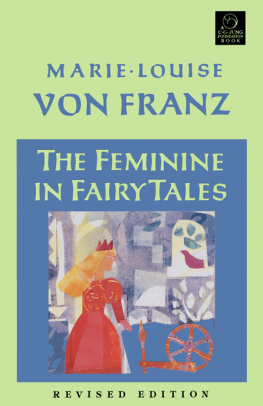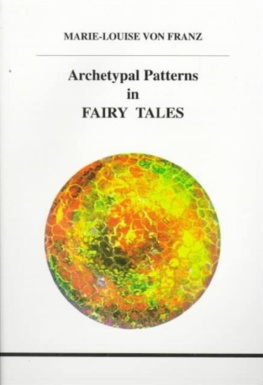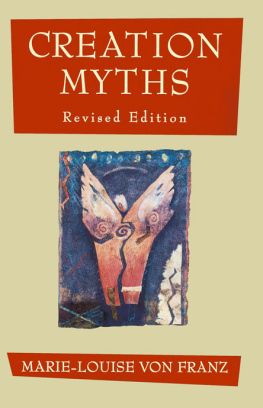Marie-Louise von Franz - Individuation in Fairy Tales
Here you can read online Marie-Louise von Franz - Individuation in Fairy Tales full text of the book (entire story) in english for free. Download pdf and epub, get meaning, cover and reviews about this ebook. year: 1987, publisher: Shambhala, genre: Science. Description of the work, (preface) as well as reviews are available. Best literature library LitArk.com created for fans of good reading and offers a wide selection of genres:
Romance novel
Science fiction
Adventure
Detective
Science
History
Home and family
Prose
Art
Politics
Computer
Non-fiction
Religion
Business
Children
Humor
Choose a favorite category and find really read worthwhile books. Enjoy immersion in the world of imagination, feel the emotions of the characters or learn something new for yourself, make an fascinating discovery.
- Book:Individuation in Fairy Tales
- Author:
- Publisher:Shambhala
- Genre:
- Year:1987
- Rating:5 / 5
- Favourites:Add to favourites
- Your mark:
- 100
- 1
- 2
- 3
- 4
- 5
Individuation in Fairy Tales: summary, description and annotation
We offer to read an annotation, description, summary or preface (depends on what the author of the book "Individuation in Fairy Tales" wrote himself). If you haven't found the necessary information about the book — write in the comments, we will try to find it.
Marie-Louise von Franz: author's other books
Who wrote Individuation in Fairy Tales? Find out the surname, the name of the author of the book and a list of all author's works by series.
Individuation in Fairy Tales — read online for free the complete book (whole text) full work
Below is the text of the book, divided by pages. System saving the place of the last page read, allows you to conveniently read the book "Individuation in Fairy Tales" online for free, without having to search again every time where you left off. Put a bookmark, and you can go to the page where you finished reading at any time.
Font size:
Interval:
Bookmark:
Sign up to receive news and special offers from Shambhala Publications.

Or visit us online to sign up at shambhala.com/eshambhala.

A C. G. JUNG FOUNDATION BOOK
The C. G. Jung Foundation for Analytical Psychology is dedicated to helping men and women grow in conscious awareness of the psychological realities in themselves and society, find healing and meaning in their lives and greater depth in their relationships, and live in response to their discovered sense of purpose. It welcomes the public to attend its lectures, seminars, films, symposia, and workshops and offers a wide selection of books for sale through its bookstore. The Foundation also publishes Quadrant, a semiannual journal, and books on Analytical Psychology and related subjects. For information about Foundation programs or membership, please write to the C. G. Jung Foundation, 28 East 39th Street, New York, NY 10016.
Individuation in Fairy Tales
Revised Edition
Marie-Louise von Franz

Shambhala
Boulder
2017
SHAMBHALA PUBLICATIONS, INC.
4720 Walnut Street
Boulder, Colorado 80301
www.shambhala.com
1977, 1990 by Marie-Louise von Franz
The text of this book is based on the transcription by Miss Una Thomas of a series of lectures given by Marie-Louise von Franz at the C. G. Jung Institute, Zurich, originally published in 1977. The present edition includes corrections and additions made by the author.
Cover art by Roberta Arenson
All rights reserved. No part of this book may be reproduced in any form or by any means, electronic or mechanical, including photocopying, recording, or by any information storage and retrieval system, without permission in writing from the publisher.
LIBRARY OF CONGRESS CATALOGING-IN-PUBLICATION DATA
Franz, Marie-Louise von, 1915
Individuation in fairy tales / Marie-Louise von Franz.
Rev. ed. p. cm.
A. C.G. Jung Foundation Book.
Reprint. Originally published: Dallas, Tex.: Spring Publications, 1977.
eISBN 9780834840836
ISBN 9780877735250 (alk. paper)
ISBN 9781570626135
1. Fairy talesHistory and criticism. 2. Individuation. 3. Symbolism (Psychology). I. Title.
[GR550.F7 1990] 89-43615
398.21dc20 CIP
BVG01
Contents
This book has originated from a series of lectures given at the C. G. Jung Institute in Zurich. It represents an attempt to bring closer to public understanding what Jung means by the process of individuation. Although it seems to be very difficult for intellectual people to understand it, individuation is a natural, ubiquitous phenomenon which has found innumerable symbolic descriptions in the folk tales of all countries. One can even say that the majority of folk tales deal with one or another aspect of this most meaningful basic life process in man. In order to remain in harmony with the simple storyteller, I have used a direct and colloquial style. The process itself is difficult enough, and one should not further complicate it by sophistication. I have on the contrary tried to bring it close to home to all of us, hoping that the reader may be as moved by the stories as I have been.
Individuation is the term with which C. G. Jung describes the psychological process of inner growth and centralization by which the individual finds its own Self. This does not mean to find ones own ego-identity, as is described by many modern psychological schools. By the term Self, Jung understands an ultimately unknowable inner center of the total personality and also the totality itself. This center can only be approached but never integrated. Our destiny and our health depend on it. In the various religions and mythologies it is symbolized by the image of the treasure hard to attain, the mandala and all images of the inner psychic manifestation of the godhead.
In this book, I have chosen to interpret a group of different fairy tales which all circle essentially around the motif of the central treasure represented as a bird or jewel, in order to show the reader some aspects of what is meant by the Self and by the difficult journey we have to undertake in order to find it.
I begin with a Spanish tale called The White Parrot. Its central motif, a magical white parrot, has been borrowed from the Orient. It is an Iranian tale which in its turn was borrowed in changed form from an Indian one, so you will be able to see not only the interpretation per se, but also how motifs migrate, are changed and built into a new setup. First, we will just naively look at the story, which is not a literary one but was picked up from among the simple people of the Spanish population and was written down in the seventeenth century. It runs as follows.
There was a rich Count who loved a very beautiful but poor young girl so much that he married her, but afterward, when he had to go away and take part in a war, he put the Countess, who was pregnant, under the care of the butler who was to look after her. But the butler fell in love with her and tried to seduce her; she refused him, and he was so angry that when she gave birth to two children he decided to slander her. The twin children were a boy and a girl and on the forehead of each was a beautiful star. The butler wrote to the Count saying that he had thought for a long time that the Countess had had an affair with a Negro but now it had become quite clear that this was so because she had given birth to two half-Negro children.
The Count was furious and wrote back saying that the Negro and the children should be killed and his wife imprisoned. The butler did not kill the children but put them in a glass box which he threw into a river, and he imprisoned the Countess.
But it happened that an old man, fishing just then in the river, saw the glass box and pulled it out in his net and took it home and found the children wrapped up in a beautiful piece of silk stuff. He and his wife decided to bring up the children, but in order to hide the stars on their foreheads they bound linen bands round them. When the old fisherman and his wife died, they left all they had to the children.
When the Count returned from the war, without any idea of what had really happened, the butler felt very uneasy. When he heard gossip about some marvelous children in the village who always wore a linen band on their foreheads, he decided that they should be removed, for he suspected that they might be the children he wanted killed. He therefore hired a devilish witch, capable of committing any crime, provided she was well paid, and ordered her to kill the children. The witch went to see the little girl when the boy was out and asked her where her brother was. The girl answered that he had gone out. The witch then remarked on her wonderful house. The child asked if she would like to see it and the witch said she would. She looked all around and said that it was all very beautiful, but that there was one thing lacking, namely a fountain of silver water, and if her brother wanted to have that he should just go and fetch it. He need only go to the spring with a little jug and bring back some of the silver water, and if he then poured it out in the courtyard they would have the same kind of silver fountain.
The old woman then went away and when the brother returned his little sister told him she wanted this fountain of silver water. The boy said that that was nonsense, and that they did not really need it and that he wouldnt go and fetch it. But the girl cried and worried him about it so much that he finally made up his mind and took a jug and set out to find the silver spring. As he went in the direction indicated by the witch he met an old man who asked him who hated him so much as to send him there? The boy replied that an old woman had told his sister that he should go and fetch the silver water and that was why he had come. The old man agreed that it was true about the silver water, but said that many dangers had to be overcome in fetching the water, for the well was guarded by a lion. Therefore before the boy approached the lion he must watch him very carefully: for when he had his eyes shut the boy must not go near him; but when his eyes were open then he would be asleep, and then the boy could get the water and run away. But he must be very quick because the lion slept very lightly. The boy went, and as the lion had its eyes open just then, he quickly filled his jug with water. When he poured it out in the courtyard a beautiful spray of silver water came up there too and both children were delighted.
Next pageFont size:
Interval:
Bookmark:
Similar books «Individuation in Fairy Tales»
Look at similar books to Individuation in Fairy Tales. We have selected literature similar in name and meaning in the hope of providing readers with more options to find new, interesting, not yet read works.
Discussion, reviews of the book Individuation in Fairy Tales and just readers' own opinions. Leave your comments, write what you think about the work, its meaning or the main characters. Specify what exactly you liked and what you didn't like, and why you think so.

